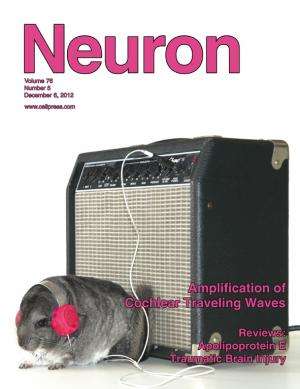Researcher describes cochlear amplification using novel optical technique

It has long been known that the inner ear actively amplifies sounds it receives, and that this amplification can be attributed to forces generated by outer hair cells in the cochlea. How the ear actually accomplishes this, however, has remained somewhat of a mystery. Now, Jonathan A. N. Fisher, PhD, and colleagues at The Rockefeller University, in New York, describe how the cochlea actively self-amplifies sound it receives to help increase the range of sounds that can be heard.
The results of their research were published in the December 6, 2012 issue of Neuron. The cover shows the study animal the researchers used to investigate amplification in the inner ear- the chinchilla. This animal is often used for hearing-related research because of the similarity it has with humans in terms of hearing and the structure of its inner ear.
Dr. Fisher received a grant for this research from the American Hearing Research Foundation in 2011.
Fisher and colleagues used a new optical technique that inactivates prestin, a motor protein involved in the movement of the outer hair cells. The outer hair cells are part of the hair cell bundles (which also include the inner hair cells)- the true sensory cells of the inner ear. The main body of the hair cells sits in the basilar membrane- the tissue that lines the interior of the bony cochlea. The "hair" part of these cells, called the stereocilia, sticks up into the fluid-filled space of the cochlea, where they are pushed by the fluid as sound waves travel through it.
The sound waves traveling down the cochlea produce actual waves that can be observed along the basilar membrane as visualized in the animation below (from the Howard Hughes Medical Institute). The cochlea picks up different sound frequencies along its length, with higher frequency sounds picked up at center of the "snail" and the lower frequency sounds being picked up at the part of the cochlea closest to the eardrum.
The outer hair cells have been known to provide amplification of sound waves picked up by the inner hair cells by actively changing their shape to increase the amplitudes of the sound waves. These outer hair cells can do this because the membrane protein can contract and cause the stereocillia to be deflected by the overlying tectorial membrane.
Fisher and colleagues developed a light-sensitive drug that when illuminated by an ultraviolet laser can inactivate prestin in select locations within the cochlea. Using this novel technique, the researchers were able to affect prestin at very specific locations along the basilar membrane.
The researchers found that by inactivating prestin at very specific locations, the sound-evoked waves that carry mechanical signals to sensory hair cells were re-shaped and of smaller amplitude- indicating that without prestin, amplification is dampened compared to what the researchers saw when prestin was allowed to function normally. Their findings reveal how prestin's molecular forces pump energy into the waves within the cochlea, and how this energy is pushed forward as the wave travels. The research also demonstrates the importance of prestin in locally amplifying these sound evoked traveling waves.












